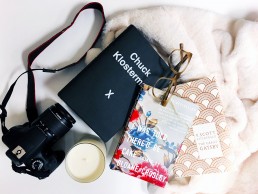7 Inspiring Instagram Accounts to Follow
Everyone hits a creative slump now and again, and in 2018 that means your Instagram sits untouched while you wait to be hit with a stroke of artistic genius, or if all else fails, for a trip to a particularly photogenic location. That's all well and good if your feed is more of a personal project, but if keeping it fresh is part of your job and awaiting inspiration is not an option, we've got 7 follow-worthy Instagram accounts to get you back in the game sooner rather than later.
May we introduce you to the cutest little café in Paris. Not only does Fragments serve what we can only assume from photographic evidence is an incredible breakfast, but they also serve up a lesson in branding consistency on social media. Their food (and coffee, obvs) photography features a consistent editing style and high-quality photos good enough to make you hop on a plane to France just to get a bite of that pastry. Even user-generated content that is reposted stays true to the brand's look and palette, creating a beautiful, cohesive, and very drool-inducing feed.
Tiny Atlas is a travel magazine with an Instagram feed that makes us want to give up our home base to become world travellers. The key to this feed's success is storytelling – images featured are so rich and provocative that you feel transported to that harbour in Denmark or rolling landscape in Rwanda.
Unsurprisingly, they also excel at Instagram Stories, which they use to “follow” someone around a new location – essentially taking you along for the ride.
The Sill is a plant seller based in New York City with a cult-like following (300k and counting), and if you share our love of plants then this follow is going to brighten your feed immeasurably. They've adeptly used a custom hashtag to build their profile and generate user content – followers happily slap #PlantsMakePeopleHappy on their own photos, giving The Sill a never-ending stream of content which they curate flawlessly. The profile page makes excellent use of Story Highlights, and posts strike an ideal balance between more sales oriented content and posts aimed at engagement.
Now granted, this NYC-based jewellery designer has a leg up on the competition simply due to the innate beauty of the jewellery featured, but they certainly now how to make the most of it. Jewellery is shown off in more styled settings – a studio closeup of a beautiful piece – as well as in real-life scenarios – an engagement ring with proposal story as caption. Think eye-candy alongside a few good tugs on the old heart strings – match made in heaven?
When you make letterboards, you are essentially creating a canvas for more beautiful memes, so the obvious potential on social media is immediately apparent. The folks at Letterfolk make good use of their product and have mastered the art of user generated content with the massively popular #letterfolkquotes. Hats off to the caption writers on task at Letterfolk who regularly make us laugh out loud with their witty captions to accompany the photos.
Andrea Nunez is a lifestyle influencer/blogger in London, England, with a second-to-none feed of gorgeous photos designed to give you life envy. Styling, shooting, and editing are decidedly on-point here – she's living out the personal Instagram feeds we'd all have, given the time and energy. Credit where credit is due!
If you’re reading this just before lunch, be forewarned: Saveur is a magazine for foodies, and you will know hunger and cravings like never before should you choose to check this account out right now. The feed is used primarily to promote recipes from the current print issue of the magazine or online, but they also feature photos of food cooked by other chefs who have tagged them on the ‘gram. Following this feed can definitely inspire you to cook this weekend rather than hopping over to Skip the Dishes yet again.
Photo from @letterfolk
Why You Need Social Media
It’s clear that social media marketing isn’t just a fad – platforms like Facebook, Instagram, Twitter, and even Pinterest are shaping the way consumers buy, growing brand loyalty, developing brand recognition, improving SEO rankings, and resulting in higher conversion rates. Not convinced? Let’s break it down.
75% of people report purchasing a product because they saw it on social media.
At the end of the day, every company is trying to sell their product – Starbucks wants to sell you coffee, your local restaurant wants to fill their seats, Honda wants to sell you a Civic. Commerce makes the world go ‘round, and studies have shown that social media marketing has a 100% higher lead-to-close rate than outbound marketing.
If you’re not on social media, you’re missing out on a huge customer base.
By the end of 2017, 22.7 million Canadians reported using at least one social media platform, and roughly three-quarters of Facebook users and one-half of Instagram users say they’re scrolling through their feeds at least once a day. Instagram just broke a billion monthly active users, and Facebook has 1.32 billion daily users. And you can speak directly to these users for a relatively low cost when compared to traditional advertising methods.
Brand recognition is important, and so is brand loyalty.
Social media platforms are the perfect opportunity to develop and express your brand’s identity, and show what you have to offer. Your profiles, when managed with a consistent and cohesive strategy, make it easier for customers to find you and learn about your brand, while also making you more familiar and accessible to existing customers. Plus, social media is dynamic by nature, allowing you to paint a fuller picture of your company’s culture and values – it’s a win-win.
Your competition is already on social media.
91% of retail brands already use at least one social media platform. They’re developing their brand voice and engaging with their audience – if you’re not taking advantage of social media marketing, you’re behind. Not having an active social media presence is like not having a smartphone.
How Instagram is Becoming the New Facebook for Brands
Brands were recently hit with an algorithmic change on Facebook aptly dubbed “Facebook armageddon,” which prioritizes “meaningful interactions” and posts from your friends and family over posts from brands. Of course, mass panic ensued. For years, Facebook has been the spot for brands to advertise and build a social following. Then suddenly, Facebook gathered all of our things and through them into the street like a cruel ex-boyfriend. Big brands owned by rockstar/scientist Elon Musk, Tesla and SpaceX, have already deleted their Facebook pages – the equivalent to, well, deleting their ex on Facebook.
Luckily, there’s another suitor in town: Instagram. Instagram, though owned by Facebook, may become the new love interest of big brands. It’s young (the majority of Instagram’s users are under 30), adaptable, and its users are fiercely loyal to brands they love (roughly 53 percent of Instagram users follow brands).
So, is it time for brands to cut ties with their cold and fickle ex, Facebook, in favour of Instagram? Maybe – and here’s why.
Adaptability
Instagram has proven its ability to quickly embrace new trends and technology – and does it really well. Take Instagram Stories, for instance. After Instagram blatantly copied Snapchat (RIP) with Instagram Stories, they saw a growth of 300 million users. Then, they stole Snapchat’s filters, effectively digging a knife into the once almighty ghost (afterwhich Snapchat finished the job themselves with their recent ill-advised advertising fiasco). And even after Instagram adopting the algorithmic timeline approach à la Facebook, versus the chronological timeline of the past, the platform’s user base is still growing.
Translation: Instagram’s continually changing interface and dynamic ability to adapt promises sustainable user growth moving forward.
Engagement
Sure, Facebook has 2 billion users making it the untouchable king of reach. But the king better guard his crown, because engagement on Instagram is unparalleled by any other major social media platform – though it has dropped since the decline of organic reach. Recent studies found that brands are seeing up to three times higher user engagement on Instagram than they are on Facebook, and afterall, isn’t engagement what we all want? Why settle for someone passively looking at your content mid-scroll, when you have another audience ready to put a ring on it – metaphorically speaking. Take Mercedes-Benz, for example. They posted a photo of their new A-Class on Facebook and quickly got 10,000 likes. When they posted the same photo on Instagram: 150,000 likes.
Granted, Instagram does have an inherent leg up on Facebook. The visual-based platform, at its core, is a hub for sharing pretty photos – a lot of pretty photos. As users scroll through their feed, the content is right there, making it easy to toss out likes like Oprah giving away free cars. And, importantly, there is no “dislike” button on Instagram.
Embracing Brands
While Facebook is pushing brands away, Instagram is pulling them in for a big bear hug. With the latest algorithm update on Facebook, updates from friends and family are being prioritized over posts and ads from brands. Okay, fair. A post from a brand sticks out like a sore thumb when mixed among status updates from your grandma and your weird aunt sharing photos of her latest sewing venture. On Instagram, however, branded content blends right in – especially content from brands who have mastered the art of gorgeous visuals. Plus, with the Explore Tab, posts by brands can be discovered by users outside of their current followers, essentially rewarding brands with good feeds. Instagram has also added a shopping feature, allowing brands to include a direct link to purchase the products shown in their photos. Can it get any easier?
More Sophisticated Tools
Facebook has long been the platform of choice for advertisers – primarily for its ability to refine your audience down to location, behaviours, jobs, and interests. No other platform could give you that kind of bang for your buck – until Instagram opened up to ads in 2015 and quickly introduced Facebook’s advertising functionality. They have since created innovative ways to advertise, such as opening up Instagram Stories to canvas ads. Not surprisingly, the number of brands advertising on Instagram jumped to two million last year – which, like our coffee consumption, roughly doubled over the previous year. With projected ad revenue of $11 million in 2019, it doesn’t look they’ll be slowing down any time soon.
Need help making the most of Instagram, or figuring out which platforms work the best for your business? We’d love to talk.
How to Repurpose Content
You’ve just finished writing a blog post. You’ve poured your heart, soul, and many, many cups of coffee into it – not to mention the expensive and time-consuming photoshoot you held to create the visuals to go with it. You finally press publish, and it’s exhilarating – you’ve put new content out into the world! You excitedly draft some posts for Twitter, Instagram, and Facebook to promote your masterpiece.
Now what?
Don’t let your time and effort in developing great content fade away into the void that is the Internet; let your brilliance live on in a fresh, reincarnated form. Your best blog post could be turned into a podcast, your best video turned into a blog post! The possibilities are endless, but here are some tips to give your repurposed content some guidance.
Find content that merits being shared again.
That blog post you struggled with and picked away at until you gave up and hit publish probably isn’t the best choice, but content that you are passionate about and that you feel has some shelf life left is fair game. Maybe you put a lot of time and effort into researching and writing a blog post on a topic you weren’t familiar with, and you ended up falling in love with the material and creating some of your best work. Or maybe your audience reacted really well toward a video you published. This is where you should start.
Find timeless content.
Just because a particular video may have performed really well on social media, doesn’t necessarily make it a good candidate for sharing again – especially if it contains timely information that is no longer relevant. A super interesting video on electoral candidates is engaging when there’s an election, but not so much once the polling stations have been closed for months – unless it warrants a relevant update of some kind. And on that note...
See if you have more to say about a topic.
As you review your shining content, keep an eye out for topics where you have new things to say, and update posts with current perspectives and statistics. This is a great way to create new content that capitalizes on something you’ve already put a lot of work into. Plus, it’s an opportunity to improve on a piece that you didn’t love, or that didn’t get the energy it deserved. It’s like getting a chance to rewrite that paper for your undergrad that was due directly after Reading Week.
If you’re revisiting a topic that pulled in good traffic the first time around, consider giving the original post a quick update, rather than creating a full new post about it. This way, you actually boost the post’s SEO value, while still putting new information into the world. Some blogging platforms will even let you change the publishing date of a blog post, so your slightly revised piece will show up on your blog like it’s brand new. When you change an original post, it’s generally considered good form to include a little note letting readers know that the post has been revisited.
Transform your popular piece into a new medium.
Here’s the big guy when it comes to repurposing content: Figure out what makes sense as an alternate form for the original content – this could be a blog post, an infographic, a video, a graphic, an Ebook, or a podcast – but don’t force your content to fit into a mould just for the sake of getting to share it again. Remember, your repurposed content needs to be high-quality too. And people can totally tell when you’ve forced something that isn’t a natural fit. A blog post on how to take better photos for social media might not make sense as an infographic, but it would make an interesting video.
When content is pulling double duty, you can create less and promote more, while reaching a wider audience and improving your SEO. And that is a definite win in our books.
Why Your Social Media May not be Working
- You don’t have a strategy on social media. Posting haphazardly, tagging a couple accounts, and calling it a day doesn’t cut it – it’s important to have a plan and specific objectives.
- You’re not up-to-date with algorithm changes. Facebook is notorious for regularly changing the way content is prioritized and served – if you don’t keep up, no one will see what you’re posting.
- Your strategy doesn’t include paid social. Facebook says we should eventually expect organic reach to hit zero – so unless you want to be talking to yourself, you’ll need to allocate budget for paid posts to supplement your organic efforts.
- You’re posting, but not engaging with the community. Engagement is a two-way street and social media is a great opportunity to connect with your followers and be part of a conversation.
- You haven’t found the posting frequency sweet spot yet. Posting once a month won’t cut it, but you also don’t want to overwhelm your followers with 10 posts a day.
Need a little help coming up with content? Check out our post on curating quality content for your feed.
Building and Expressing Your Brand
The average person is bombarded with roughly 6,000 brand messages everyday – on the radio, on TV, on social media, on billboards. So how can you cut through the noise? Simple and consistent branding that sets you apart from everyone else. But that’s trickier than it might first seem.
It can help to think about your brand as a person. You want to have a clear sense of you who are – how you dress, how you speak, how you act – and who you are shouldn’t change depending on where your audience bumps into you. Think about social media maven Chrissy Teigen. Everything she posts is consistent with the funny, witty, and personable brand she’s built, and she has about a gajillion engaged followers who know what to expect and feel like they can trust her. Whether it’s the personal brand of a model-turned-influencer or your own, good brands are built through the consistent delivery of their personality through all points of contact.
What brand expression is… and what it is not
One of the best ways to lay a solid foundation for a strong brand is by beginning with what we call a “brand expression.” Our goal with this project is to work together with you to define how your brand looks and sounds. At the end of a brand expression project, you will not walk away with a website design, an ad design, or a brand book design. You will walk away with a clear and strong knowledge of what your brand looks and sounds like, which will inform all future projects and make everything that happens next – whether that’s a website build, social media accounts, or a mass campaign – a whole lot easier. Your brand expression will establish a memorable and consistent look and voice, and the end product – a simple pdf document full of the colours, photos, and words that make your brand your brand – will act as a touchstone for any future collateral or content.
Brand expression is not a logo design project, although evaluating and integrating an existing logo should be part of the process, and developing a new logo can definitely be included when needed. Ultimately, your brand needs to be more than just a logo, and clearly defining how you express your brand’s values, promises, and personality is where brand expression comes in.
The process
To make sure we get it right, we do our homework. We’ll start with an in-depth discovery session with you, where we’ll talk about your business, the industry you are a part of, your target audience, your goals, and what sets you apart – anything and everything we create comes out of your answers to these questions, along with our research into what your competition is doing.
After our discovery session with you, we’ll fine-tune a list of tone words that describe the personality of your brand in much the same way you would describe the personality of a person. The words are used as internal guideposts, making sure that everything created in the future stays consistent, and they’re not necessarily meant to be used externally – your company should be these words.
To start defining your external voice, we’ll develop a brand story that succinctly explains what you do, how you do it, and why you do it, along with some key messaging – all based on our discovery process with you. It’s critical to know how your brand speaks, and to be consistent in your tone. People like reliability and consistency – not just in branding, but also in life. Do you remember how shocked you were the first time you heard your grandma swear? It was probably off-brand enough that it shook you to your core (and you can probably still tell that story with painstaking detail).
Along with defining your voice, we’ll use the tone words to pull together a visual representation of your brand. We’ll determine your brand fonts, a colour palette, photography style, and any graphic devices that your brand has in its toolkit.
The finish, and the future
A brand expression is not in and of itself a finished external marketing piece – it’s an important foundation to build off of. You need to walk before you can run, friend, and you need to know your brand well before you start showing it to the world. At the end of this process, we should both have a really solid sense of what your brand looks and sounds like, and from there, the world is your oyster. The brand expression will be a constant guide to whatever comes next. Ultimately, we’re looking to create an emotive and memorable look and voice and then be consistent with it, so that everyone from your staff to your target audience has the same strong sense of who you are.
To see some examples of brand expression projects, check out this page and filter by “branding.” If your own brand could use a little more clarity to cut through the clutter, get in touch.
How to Consistently Curate Quality Content for Your Feed
Publishing content consistently across your social media channels is important, but so is the quality of content you put out to the infinite space that is the Internet. Your ability to create high-quality, engaging material has never been more important – your social media accounts are the world’s first impression of your brand. Do you want to look put together and professional, or like you rolled out of bed, smelled the first shirt you saw on your floor to see if it’s clean, and ran out the door?
Here are some tips to make sure you’re always armed with great content.
Develop a Strategy
The first thing you need to do is decide your posting strategy – including frequency, ratio of unique content versus shared content, and platforms you want to use. All of these factors will vary depending on your business, budget, and what you are trying to accomplish.
As a general rule, the more often you post, the higher your engagement will be and the faster you will gain followers. It seems like common sense, but you’d be surprised. Make sure you find a balance between oversaturating your followers’ timelines and staying top-of-mind, though this will vary between platforms. On Twitter, for example, you can get away with posting much more frequently than you can on Instagram. Think about these nuances when developing your strategy. How often do you like to see posts from your favourite brands on Instagram: once a day, or eight times a day?
Just like you need to find the perfect balance of posting too much versus posting too little, you also need to decide how much original content to create for your social media accounts (photos, graphics, videos, blog articles) and how much you are going to share from other sources. Again, this ratio will change with each platform you use. On Twitter or Facebook, it is much more common to share other people’s content – the platforms are designed for it. On Instagram, not so much. This will influence the frequency of your posting as well: don’t post on Instagram every day if you don’t have good content to post.
Find Sources for Shared Content
Don’t scour Google every time you’re trying to come up with a new post. When we’re looking to post shared content on social media, like articles from other sources, we keep a list of relevant websites to check first for each of our clients. There’s no point in walking around the entire grocery store when all you need is milk.
You also need to make sure you are pulling pieces from reliable sources. Remember in school when Wikipedia didn’t ever count as a source you could use for your essay? The same rules apply in the real world too. Make sure you share information that is accurate, on brand, and not offensive. Read over every article before you post it, and read through an overly critical lens.
This is also where user-generated content comes in handy. Do you have an engaged audience? Show off their work! Not only does it take the pressure off of you to constantly create, but it also encourages others to create work as well.
Create High-Quality Content
Here’s the hard part. To have a quality feed, you need to create quality posts – whether that’s blog entries, photos, videos, graphics, or ideally, all of the above. To keep your audience engaged and interested, you need to create a variety of content. How fast did you unfollow that girl you went to high school with who only posts selfies of herself? Probably the second you got your diploma. Once your followers realize your posts are all the same, they’ll get bored and hit unfollow.
A tip to ensure you always have content is to always keep creating as a priority. Take lots of photos, jot down ideas for blog entries when you think of them in the middle of the night, create another video when you find yourself with time to kill. Prioritizing content creation will help make sure your reserve of posts never runs dry.
Learn How to Repurpose Content
Do you get the impression that major brands like Sephora hold an expensive photoshoot every day so that they have material to post? No chance. Brands plan regular shoots throughout the year and keep the resulting content in their back pockets, doling it out post by post until the next shoot. Take some detail shots, some wide shots, some shots with a human presence – mix it up!
You can also repurpose your blog posts by sharing them on multiple accounts (with different captions to keep your audience interested), creating graphics with key quotes, and making infographics. And, you can turn your videos into blog posts, GIFs, and photos. Content creation may seem like a pricey, time-consuming endeavour, but you can stretch the material super far if you learn how to reuse it. Plus, it gets your work seen by more people. On average, 50% of articles get shared eight times or less on social media – that cuts pretty deep after you spent hours writing, editing, and producing visuals. Squeeze every last drop of creative juice out of your big creative projects, and you’ll have content to spare.
Looking to take your unique content to the next level? Check out our post on how to take better photos.
Making Better Instagram Stories
The verdict is in: Instagram Stories is here to stay. 300 million people actively use Instagram Stories everyday (take that, Snapchat). And since the addition of Instagram Stories, users under 25 are spending upwards of 32 minutes a day on Instagram – and people say we don’t have hobbies.
Instagram Stories is a great way to share more content and engage more with your audience. Especially with the recent Instagram algorithm shift (just let the players play, Instagram), it’s more difficult to reach your target audience – only about 10 percent of your followers actually see your posts. The algorithm pushes down posts with low engagement, and rewards posts with lots of engagement so more people will see it. In theory, this is to give users a more intuitive experience – they are supposed to be more likely to see something they’re interested in, from an account they care about. But in practice, it drops your reach and impressions like nobody’s business. Instagram Stories helps combat this – your followers will see your story at the top of their feed, keeping your brand top-of-mind. The algorithm also takes engagement with your Instagram Stories into account – ultimately rewarding you with a higher-up slot on the feed if your Story gets views.
After all that, what we’re trying to say is that Instagram Stories is important. With that in mind, here are some tips for making the most of the new(ish) medium.
Stay on Brand
Your Instagram Stories feed isn’t just a throwaway place for pictures that are ok, but not good enough for your feed. Everything you post – yes, everything – contributes to your audience’s understanding of your brand. So while a more behind-the-scenes approach can really excel on Stories, posting a video of one of your co-workers sleeping at their desk probably isn’t the best choice. Showing client work, new products you have in store, or a company lunch, for example, helps your audience connect with your brand on a more personal level. It’s like watching a DVD (remember those?) with the commentary on – you learn more about the people behind the movie and by the end, you feel like you’re best friends with Tom Hanks.

Tell a Story
It’s called Instagram Stories for a reason. Make sure you have a beginning, middle, and end, as well as a purpose to your Story. Each post should add value or context. Have a new blog post out? Use your Story to drive people to your blog by including a call to action. Are you on location? Give your followers a behind-the-scenes shot. And if you’re feeling really bold, try your hand at Instagram Live.
Use Location and Hashtag Stickers
Just like with regular posts, you can include geotags and hashtags to increase your discoverability in Instagram Stories. Obviously, don’t go overboard – the inclusion of location and hashtag stickers shouldn’t be at the cost of good design. You can also change the colour of a sticker by tapping it – the default sticker has a white background and bold purple text, but you can change it to a more subtle transparent gray background with white text.
Make it Look Good
Pay attention to detail – your Instagram Story is a little piece of art. Make sure the colours match and are consistent with your branding, don’t block important details with your text or stickers, and pay attention to the balance and composition – basic elements of design matter. Even though your story will only be available for 24 hours (unless you save it as a highlight), lots of people will see it.
Take advantage of the new fonts Instagram added (there’s FIVE!), play around with the colour of the text to make it stand out, use the custom colour selector feature, add stickers and GIFs! Instagram users expect you to use the new features to improve the quality of your Story, so make something exciting and engaging. Bonus: Instagram lets you pull from your camera roll to post in your Story, so you can create Stories ahead of time – which means you really have no excuse for an ugly layout or illegible text.
Need some inspiration? Here are some accounts crushing the Instagram Stories game.
Taking Better Photos for Social Media
Long gone are the days of posting any photos you like on your Instagram account – sorry to be the bearer of bad news. To stand out among the other 800 million active users, you need to try a little harder. Photos need to be crisper and more professional looking, your feed needs to be cohesive, and to top it off, you need consistent engagement to make sure your posts are seen by your followers.
Keep reading for a crash course in photography from someone who spends way too much time taking and editing photos for social media.
Lighting
The difference lighting makes in a photo is huge. A photo taken in a dimly lit restaurant where you can barely see the food doesn’t have the same effect as a vibrant, bright photo showing how fresh the produce is. Some lighting issues can be fixed with editing, but it’s much easier to get it right the first time. The best lighting for photos is natural light, but not direct sunlight, which will overexpose your photo. Dimly lit photos will also lose some of their quality, especially if the photo was shot on a phone. Brightening a dark iPhone photo can result in grainy, low-quality shots that look (and probably are) over-edited. Haphazardly throwing Reyes on your photo right before posting won’t help your cause, either.
The lighting in your photo will also affect the colour and the mood. Photos with less light will feel moodier and be more monochromatic, while brighter photos will be more vibrant. Colour and lighting is super important, not only when it comes to the quality of your photography, but also when it comes to branding and consistency in your Instagram feed. Ideally, you want your feed to be uniform – think of it as one large picture rather than separate pieces. By keeping the lighting and colour similar or complementary in your photos, you can make sure your feed is consistent with your branding.
Balance
Creating a balanced photograph begins by arranging both positive and negative aspects within your frame, and by making sure one element doesn’t outpower the others. There are four main types of balance to consider when composing a photo: symmetrical, asymmetrical, radial, and crystallographic. Symmetrical balance creates a sense of harmony and emphasizes sameness, though it can also feel boring and static. In a symmetrical photo, both sides are evenly weighted on an axis in the centre.
Asymmetrical balance is created by having unequal weight on each side of your composition. Typically, asymmetrical balance is more dynamic and interesting, but it can be more difficult to achieve because the visual elements are more complex. A good rule of thumb is to balance a dominant visual element on one side of your frame with a handful of lighter elements on the other side.
Radial balance occurs when all the elements of your photo radiate (get it?) from a common centre. The easiest way to think about radial balance is to picture looking down a spiral staircase. Maintaining a focal point is easy because the element you are trying to emphasize will be in the middle of your photo.
Crystallographic balance is balanced chaos. Think about the perfect Instagram flatlay: everything in the photo is in the exact right spot, but it is not super clean. There is no clear element being emphasized – each element shares a uniform emphasis.
Remember, balance doesn’t always have to be split down the middle. Vary the angles and composition of your photos to avoid a boring Instagram feed.
Contrast
Creating contrast within a photo makes sure that your elements aren’t blending together. You can create contrast with colour, with shapes, and with sizes. Contrasting colours is the easiest to imagine – put light colours beside dark colours to make both colours stand out, for example. Colour contrast becomes especially important when shooting on a set background because you don’t want to lose elements of your foreground to your background. Have you ever seen those hilariously tragic school photos where the subject is wearing the same colour shirt as the background so they look like a floating head? Yeah, contrast is important.
Contrasting shapes creates interest within a photo. Especially within a crystallographically balanced photo (this is a test to make sure you were paying attention – did you pass?), varying the shapes you use creates a more dynamic photo. A great example of this is taking a photo of a table with lots of food on it – using some circular plates with some rectangular platters gives the eye more to look at.
Contrasting sizes helps draw attention to your focal point – the bigger the element, the more important it seems within the frame. In general, contrast makes your photos more interesting and gives the viewer more to explore while helping get your message across more effectively.
Space and Framing
The way you frame your subject also says a lot – sometimes, the elements you leave out of a photo say just as much as the elements you leave in a photo. Negative space is a beautiful thing – the absence draws attention to the important elements of your photo and keeps your frame from becoming too busy.
This brings us nicely to framing. The framing of your photo can make your composition more dynamic or create a sense of unity and harmony. If you want your photo to look orderly, frame your subject so that the lines in the photo are parallel with the edge of the photo. If you want to add interest to your flatlay, create interesting angles between the edge of the photo and the subjects in your frame – seeing space is important. You can also create interest by framing your photo in an unusual way – like by having the background take up the bulk of the frame while keeping your subject small.
Lastly, one of the best photography tips is to take lots of photos. Don’t snap your shutter once and call it quits – play with your framing, your angles, the lighting, and the composition to make sure you capture something that works. How many selfies do you take before finally posting one? Probably a lot more than one (your camera roll doesn’t lie).
The Best Plants for Your Office
We’re no strangers to office plants. In fact, we’re unofficial experts at keeping our space full of happy and healthy greenery. If you find yourself killing more plants than you’re keeping, check out our list of low-maintenance options to bring a little green to your office.
Snake Plant (Sansevieria trifasciata)
Snake plants are almost impossible to kill and are known for their ability to survive in unsuitable growing conditions (hello, fluorescent lights). They can grow anywhere from 8 inches to 12 feet high, but they grow very slowly. Indirect sunlight is the best option for this hardy plant, but it’ll survive in full sunlight and low light as well. The biggest killer of snake plants is overwatering – you want the soil to completely dry between waterings so that the roots don’t rot.
There are around 70 different species of snake plant, which all look slightly different. “Mother-in-law’s tongue” (aptly named because of its sharp, pointed leaves – genius) is most common for gardening, but we recommend the robusta species for offices. Its leaves are shorter and wider than other species of the snake plant, making it ideal for compact spaces. It is also lovingly dubbed the “bulletproof plant,” so that should be an indication of how impossible this plant is to kill.
Golden Pothos (Epipremnum aureum)
Pothos, also known as Devil’s Ivy, is a really hardy vine that quickly grows green, glossy leaves. It is one of the easiest houseplants to grow, as it doesn’t need much sunlight or water – making it perfect for the neglectful plant-lover. The biggest chore with Devil’s Ivy is that it just keeps growing and growing.
If you find the vines of your plant getting too long, trim them, place the trimmed vines in water for a couple weeks until they grow roots, and then repot them. Endless plants for you and all your friends (or for yourself, we don’t judge).
Peace Lily (Spathiphyllum)
Peace lilies are favourite house plants. They are ridiculously easy to care for and, get this, flower in the springtime. They thrive in the shade, though some varieties can stand more light than others. In the summer, make sure you water peace lilies frequently. If you want extra happy plant babies, mist the leaves too. Slow down on your watering in the winter, but don’t let the soil dry out. You probably won’t underwater a peace lily; they are more prone to dying from overwatering.
The flowers on this plant last for a long time, and you can actually force your plant to bloom twice a year. Keep your plant fertilized and in the shade, and you could have flowers on your desk for several months of the year, and the peace lily will never whine about you not texting them back.
Air Plants (tillandsias)
Air plants are the most low maintenance plant – they don’t even need soil. How, you ask? Magic. They do best in areas with indirect sunlight, but really can survive anywhere. While air plants don’t need soil, you still need to water them. Depending on the type of plant you have, the watering methods will vary. A safe bet is soaking the plant in a glass of water around once a week. This will let the plant absorb water, or relax after a long stressful week. After you’re done soaking the plant, gently shake off the extra water, dry it off, and you’re good to go.
Plastic Plants from IKEA (fejka)
Did you kill even the most hardy of plants on our list? You must have a talent. May we make a suggestion? Maybe plants aren’t for you. Keep your space green without the hassle of ever needing to water a plant, ever. Bonus: avoid the humiliation of sneaking another dead plant out of your cubicle.








